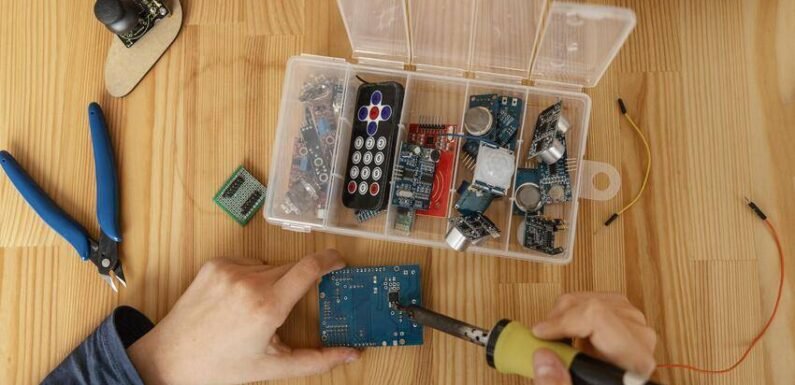
Electronics have become integral to daily life, but one must consider what happens to them at the end of their lifespans. To better support a circular economy, an alternative type of circuit board has been developed that is uniquely constructed out of biodegradable leaves. If adopted by electronics manufacturers, leaf-based circuit boards — also known as leaftronics — would be a notable step forward in sustainable technology.
The Problem With Printed Circuit Boards
Printed circuit boards (PCBs) provide conductive layers to connect electronic device components. Although they are useful in many applications, they significantly contribute to electronic waste, which refers to any discarded product with a plug or battery.
Global e-waste is on the rise, with 82 million tonnes of e-waste projected for 2030, according to the United Nations Institute for Training & Research. The majority of e-waste ends up in landfills, where it can cause detrimental damage to the environment. PCBs are generally considered unsustainable due to their resulting pollution and resource depletion. Only a small portion of e-waste is recycled or ethically disposed of through hydrometallurgy or similar processes.
The Science Behind Leaf-Based Circuits
To combat this problem, researchers at the Dresden University of Technology have created a biodegradable electronic circuit board made from tree leaves, a renewable resource. The leaves are stripped to their skeletons and dipped into a biodegradable polymer. According to InCompliance Magazine, standard electronic components can be easily attached to the leaf-based board.
According to Antroposcene Magazine, these leaftronics rival electronics made of plastic or glass, offering a flexible surface that can handle high manufacturing temperatures. Like standard PCBs, leaf-based circuit boards employ a modular electronics design that allows for easier customization and repairs to extend the board’s lifespan. They are believed to be suitable for modern electronic applications.
How Leaf-Based Circuits Can Reduce E-Waste
According to Earth.org, e-waste is problematic because regular circuits release toxic compounds into the air, soil, and groundwater. Prolonged exposure to these chemicals can even cause health issues. They also add to the growing burden of overflowing landfills.
Leaftronics offer a safer alternative because they are constructed of plants and a biodegradable polymer, allowing them to decompose in the environment. At the end of their lifespan, the metal and copper components can be removed with an ultrasonic acid bath and recycled for further use, supporting a circular economy. The leaf-based board itself can be naturally composted. Leaf-based circuit boards have a three times smaller carbon footprint than paper, according to All About Industries.
Challenges and Limitations of Leaf-Based Electronics
The production of leaf-based circuit boards and other leaf-based electronics involves technical hurdles. Circuit boards must be able to withstand prolonged use and environmental factors, such as dust buildup, vibration stress, and chemical exposure. Unlike regular PCBs— which are made with materials that can last thousands of years — leaftronics are intended to break down after use. While this is an advantage for sustainability, it poses a challenge for durability and reliability in demanding industries.
Science Magazine notes that another challenge is convincing electronics manufacturers to adopt the technology when their current materials are incredibly robust and have set industry standards. Many manufacturers are accustomed to their processes, so it will take more than some successful lab tests for them to consider the switch.
The Current State of Leaftronics
The technology is currently at the pilot research and prototype stage, under the project name “UnbeLEAFable.” Dr. Hans Kleemann — professor and researcher at the Dresden University of Technology — has received the equivalent of $583,375 to fund his leaftronics project and continue developing the technology. His research could offer a clear path toward commercialization that would meet the growing demand for sustainable electronics.
More PCB Alternatives
Leaf-based circuit boards are not the only green alternatives to PCBs. Seokheun Choi — professor at the State University of New York — has created a prototype for paper-based circuit boards soaked in wax. According to Chemistry Views, these circuit board alternatives are flexible and thin and perform properly. They can be burned to ash at the end of their use.
Cellulose-based circuit boards are another emerging technology. Several researchers and organizations worldwide — including the Swiss Federal Laboratories for Materials Science and Technology — are developing these recyclable circuit boards. According to a story published in NewsWise, fine cellulose fibrils can be made from wood pulp or agricultural waste and stick together without additives.
The Future of Sustainable Electronics
Cutting-edge leaftronics and more sustainable alternatives to standard PCBs offer a significant step toward sustainability in the industry. They can be made with renewable materials and recycled or composted after use to contribute to a circular economy. Although leaftronics are not as permanent and robust as PCBs, they could be a solution for combating e-waste and its consequences on the planet.
Tech World Times (TWT), a global collective focusing on the latest tech news and trends in blockchain, Fintech, Development & Testing, AI and Startups. If you are looking for the guest post then contact at techworldtimes@gmail.com

